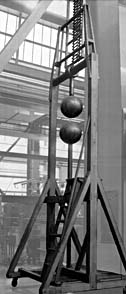|

|  |

UT exhibits early TVA objects and images and Balthazar Korab's architectural photographs
by Heather Joyner
This year marks the 65th anniversary of the Tennessee Valley Authority, and the Ewing Gallery's October show features works produced during TVA's first decades. Also on view is photography by Balthazar Korab. A visual cornucopia for architecture enthusiasts and the uninitiated alike, the current exhibit says much about various structures' power to express cultural values.
Approximately 20 display cases contain TVA-related items. From an aesthetic perspective, it hardly matters that what appear to be colorful mills for mutant coffee beans are instead devices for preventing runaway elevator cars at Wilson and Kentucky Dams. Along with other contraptions and instruments made of brass, glass, wood, and/or steel, they are elaborate yet no-nonsense; examples of design both utilitarian and sublime. Equally seductive in terms of scale and craftsmanship is an 11x14 Studio Deardorff camera with bellows looking like some otherworldly creature's breathing apparatus, used to document dams-in-progress. Yet these objects are positively Lilliputian when compared with projects depicted in photographs and drawings.
I'll never forget first experiencing Hoover Dam during a post-midnight drive from Flagstaff to Las Vegas. Although I grew up in previously lakeless East Tennessee, transformed by the surrender of some 285,000 acres to TVA, I'd not approached any of my native state's numerous dams after sundown. Nor were they "heroic" in quite the same way. Hoover Dam that night had the eerie grandeur of other massive and isolated structures, but possessed additional drama. Nevertheless, it lacked a certain earthiness and harmony with its surroundings, what Walter L. Creese in his essay "The TVA As An Allegory" described as an "inspiring earnestness." Creese wrote, "Beginning with Norris dam, people were invited into the TVA buildings to enjoy them. The powerhouses had reception vestibules. As with the Early Christian basilicas, the very warmth of the surface materials...were calculated to mysteriously nourish the habit of denial and asceticism for the ever-present faith, this time in technology, as often happens in distress periods in the U.S. The chambers for housing the machinery came close to looking like shrines without priests, with the hum and vibration of the turbines and generators in the shadows offering the invocation."
Hoover Dam's haunting quality is echoed in a nighttime photograph of Fontana Dam under construction (where crews worked 'round-the-clock until 1944, gearing up to provide energy to run Oak Ridge and manufacture aircraft aluminum). Despite dump trucks and a rooftop reading "Safety First!", the image is decidedly futuristic—with fairylandish bursts of light resulting from the film's prolonged exposure. The complexity of other photographs showing incomplete sites lends them a foreboding quality. It's as if we're looking into the very minds of the sites' creators. As the recently deceased Brown University professor and historian William H. Jordy put it in Built For the People of the United States: Fifty Years of TVA Architecture, what we see suggests that this was" ...the way the modern world was supposed to happen."
By employing my father, TVA essentially fed and clothed my family. However, I've never turned a blind eye toward its controversies, some existing long before the nuclear era. For the environmentally-conscious and 7,400 displaced families, TVA brought more than "...dignity... into a place where [it] had not been seen since the Civil War..." (Creese); it brought trouble, as well. But Creese views TVA's "upgrading" of an unnavigable and devastatingly impoverished area as ultimately well-intentioned. He wrote, "Its weaknesses were also its virtue. It was an apology to a particular region for the fact that it had been left outside so long." No apologies need be made for works presented in this show. Minimalist sketches of the Hiwassee Dam hang alongside S. H. Gurnee's romantic drawings of Norris Dam and the South Holston Project. Variety abounds.
Which brings us to Korab's 40 photographs. Associated with Le Corbusier, Mies van der Rohe, Eero Saarinen, and Frank Lloyd Wright, Korab's career as "an architect who takes pictures rather than a photographer who is knowledgeable about architecture" has spanned decades following his 1926 birth in Hungary. Rome by De Chirico is from his and Astra Zarina's book Roofscapes of Rome. Says Korab, "Among the endless studies of the Eternal City, we hit on an original one, I think, and we had fun." In contrast are stunning prints gracing the east wall—of Michigan buildings reflecting an austerity found in Walker Evans' American South. One image of an abandoned and severe-looking Grass Lake schoolhouse built in 1878 speaks of simpler times, whereas another (of a Leelanau farm during a '70s snowstorm) evokes a sense of lost family closeness. Korab's remarkable Chicago Alleys from 1959, with its maze of fire escapes receding into infinity, returns us to the urban landscape.
All of the above might serve to remind us of the impermanence of the seemingly permanent, be it in the glorious form of a dam, the humble shape of a house, or the figure of a man like Jordy (who was my teacher and friend). There's something for everyone.

|